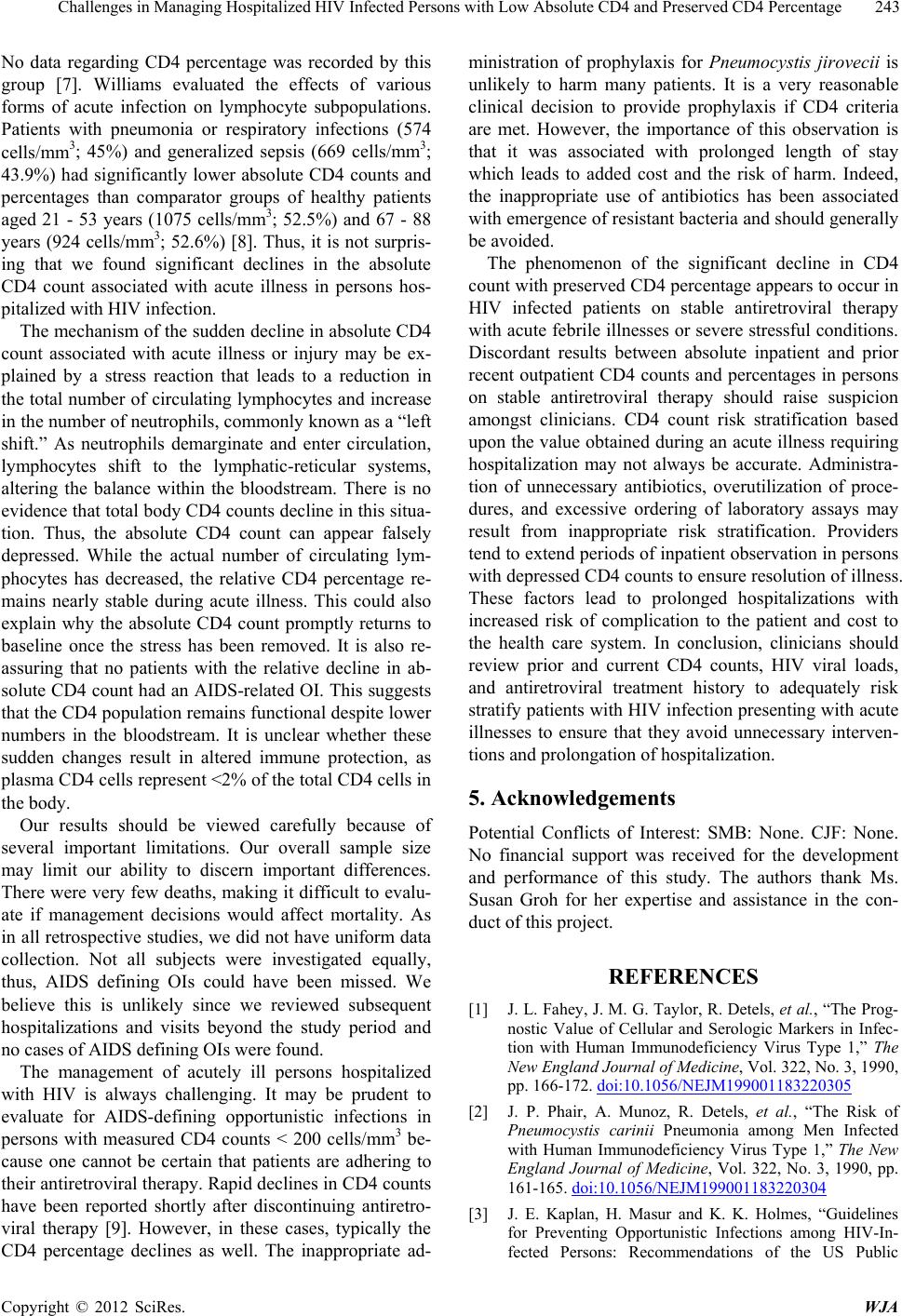
Challenges in Managing Hospitalized HIV Infected Persons with Low Absolute CD4 and Preserved CD4 Percentage 243
No data regarding CD4 percentage was recorded by this
group [7]. Williams evaluated the effects of various
forms of acute infection on lymphocyte subpopulations.
Patients with pneumonia or respiratory infections (574
cells/mm3; 45%) and generalized sepsis (669 cells/mm3;
43.9%) had significantly lower absolute CD4 counts and
percentages than comparator groups of healthy patients
aged 21 - 53 years (1075 cells/mm3; 52.5%) and 67 - 88
years (924 cells/mm3; 52.6%) [8]. Thus, it is not surpris-
ing that we found significant declines in the absolute
CD4 count associated with acute illness in persons hos-
pitalized with HIV infection.
The mechanism of the sudden decline in absolute CD4
count associated with acute illness or injury may be ex-
plained by a stress reaction that leads to a reduction in
the total number of circulating lymphocytes and increase
in the number of neutrophils, commonly known as a “left
shift.” As neutrophils demarginate and enter circulation,
lymphocytes shift to the lymphatic-reticular systems,
altering the balance within the bloodstream. There is no
evidence that total body CD4 counts decline in this situa-
tion. Thus, the absolute CD4 count can appear falsely
depressed. While the actual number of circulating lym-
phocytes has decreased, the relative CD4 percentage re-
mains nearly stable during acute illness. This could also
explain why the absolute CD4 count promptly returns to
baseline once the stress has been removed. It is also re-
assuring that no patients with the relative decline in ab-
solute CD4 count had an AIDS-related OI. This suggests
that the CD4 population remains functional despite lower
numbers in the bloodstream. It is unclear whether these
sudden changes result in altered immune protection, as
plasma CD4 cells represent <2% of the total CD4 cells in
the body.
Our results should be viewed carefully because of
several important limitations. Our overall sample size
may limit our ability to discern important differences.
There were very few deaths, making it difficult to evalu-
ate if management decisions would affect mortality. As
in all retrospective studies, we did not have uniform data
collection. Not all subjects were investigated equally,
thus, AIDS defining OIs could have been missed. We
believe this is unlikely since we reviewed subsequent
hospitalizations and visits beyond the study period and
no cases of AIDS defining OIs were found.
The management of acutely ill persons hospitalized
with HIV is always challenging. It may be prudent to
evaluate for AIDS-defining opportunistic infections in
persons with measured CD4 counts < 200 cells/mm3 be-
cause one cannot be certain that patients are adhering to
their antiretroviral therapy. Rapid declines in CD4 counts
have been reported shortly after discontinuing antiretro-
viral therapy [9]. However, in these cases, typically the
CD4 percentage declines as well. The inappropriate ad-
ministration of prophylaxis for Pneumocystis jirovecii is
unlikely to harm many patients. It is a very reasonable
clinical decision to provide prophylaxis if CD4 criteria
are met. However, the importance of this observation is
that it was associated with prolonged length of stay
which leads to added cost and the risk of harm. Indeed,
the inappropriate use of antibiotics has been associated
with emergence of resistant bacteria and should generally
be avoided.
The phenomenon of the significant decline in CD4
count with preserved CD4 percentage appears to occur in
HIV infected patients on stable antiretroviral therapy
with acute febrile illnesses or severe stressful conditions.
Discordant results between absolute inpatient and prior
recent outpatient CD4 counts and percentages in persons
on stable antiretroviral therapy should raise suspicion
amongst clinicians. CD4 count risk stratification based
upon the value obtained during an acute illness requiring
hospitalization may not always be accurate. Administra-
tion of unnecessary antibiotics, overutilization of proce-
dures, and excessive ordering of laboratory assays may
result from inappropriate risk stratification. Providers
tend to extend periods of inpatient observation in persons
with depressed CD4 counts to ensure resolution of illness.
These factors lead to prolonged hospitalizations with
increased risk of complication to the patient and cost to
the health care system. In conclusion, clinicians should
review prior and current CD4 counts, HIV viral loads,
and antiretroviral treatment history to adequately risk
stratify patients with HIV infection presenting with acute
illnesses to ensure that they avoid unnecessary interven-
tions and prolongation of hospitalization.
5. Acknowledgements
Potential Conflicts of Interest: SMB: None. CJF: None.
No financial support was received for the development
and performance of this study. The authors thank Ms.
Susan Groh for her expertise and assistance in the con-
duct of this project.
REFERENCES
[1] J. L. Fahey, J. M. G. Taylor, R. Detels, et al., “The Prog-
nostic Value of Cellular and Serologic Markers in Infec-
tion with Human Immunodeficiency Virus Type 1,” The
New England Journal of Medicine, Vol. 322, No. 3, 1990,
pp. 166-172. doi:10.1056/NEJM199001183220305
[2] J. P. Phair, A. Munoz, R. Detels, et al., “The Risk of
Pneumocystis carinii Pneumonia among Men Infected
with Human Immunodeficiency Virus Type 1,” The New
England Journal of Medicine, Vol. 322, No. 3, 1990, pp.
161-165. doi:10.1056/NEJM199001183220304
[3] J. E. Kaplan, H. Masur and K. K. Holmes, “Guidelines
for Preventing Opportunistic Infections among HIV-In-
fected Persons: Recommendations of the US Public
Copyright © 2012 SciRes. WJA